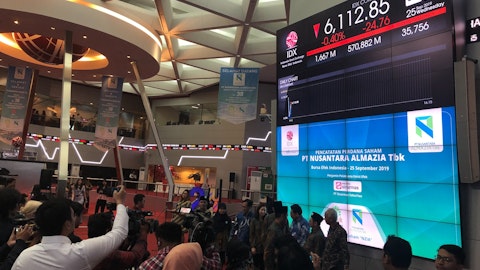Applied Optoelectronics, Inc. (NASDAQ:AAOI) Q4 2023 Earnings Call Transcript February 22, 2024
Applied Optoelectronics, Inc. isn’t one of the 30 most popular stocks among hedge funds at the end of the third quarter (see the details here).
Operator: Good afternoon. I will be your conference operator. At this time, I would like to welcome everyone to Applied Optoelectronics’ Fourth Quarter and Full Year 2023 Earnings Conference Call. All lines have been placed on mute to prevent any background noise. After the speaker’s remarks, there will be a question-and-answer session. [Operator Instructions] Please note, this call is being recorded. I would now like to turn the call over to Lindsay Savarese, Investor Relations for AOI. Ms. Savarese, please you may begin.
Lindsay Savarese: Thank you. I’m Lindsay Savarese, Investor Relations for Applied Optoelectronics. I am pleased to welcome you to AOI’s fourth quarter and full year 2023 financial results conference call. After the market closed today, AOI issued a press release announcing its fourth quarter and full year 2023 financial results and provided its outlook for the first quarter of 2024. The release is also available on the company’s website at ao-inc.com. This call is being recorded and webcast live. A link to the recording can be found on the Investor Relations section of the AOI website and will be archived for one year. Joining us on today’s call is Dr. Thompson Lin, AOI’s Founder, Chairman and CEO; and Dr. Stefan Murry, AOI’s Chief Financial Officer and Chief Strategy Officer.
Thompson will give an overview of AOI’s Q4 results, and Stefan will provide financial details and the outlook for the first quarter of 2024. A question-and-answer session will follow our prepared remarks. Before we begin, I would like to remind you to review AOI’s Safe Harbor statement. On today’s call, management will make forward-looking statements. These forward-looking statements involve risks and uncertainties as well as assumptions and current expectations, which could cause the company’s actual results, levels of activity, performance or achievements of the company, or its industry to differ materially from those expressed or implied in such forward-looking statements. In some cases, you can identify forward-looking statements by terminology such as believes, forecast, anticipates, estimates, projects, intends, predicts, expects, plans, may, should, could, would, will, potential or things or by the negative of those terms or other similar expressions that convey uncertainty of future events or outcomes.
The company has based these forward-looking statements on its current expectations, assumptions, estimates and projections. While the company believes these expectations, assumptions, estimates and projections are reasonable, such forward-looking statements are only predictions and involve known and unknown risks and uncertainties, many of which are beyond the company’s control. Forward-looking statements also include statements regarding management’s beliefs and expectations related to the expansion of the reach of our products into new markets and customer responses to our innovation, as well as statements regarding the company’s outlook for the first quarter of 2024. Except as required by law, we assume no obligation to update forward-looking statements for any reason after the date of this earnings call to conform these statements to actual results or to changes in the company’s expectations.
More information about other risks that may impact the company’s business are set forth in the Risk Factors section of the company’s reports on file with the SEC, including the company’s annual report on Form 10-K and the company’s quarterly report on Form 10-Q. Also, all financial results and other financial measures discussed today are on a non-GAAP basis, unless specifically noted otherwise. Non-GAAP financial measures are not intended to be considered in isolation or as a substitute for results prepared in accordance with GAAP. A reconciliation between our GAAP and non-GAAP measures as well as a discussion of why we present non-GAAP financial measures are included in our earnings press release that is available on our website. I’d like to know that data of our first quarter earnings call is currently scheduled for May 09, 2024.
Now I would like to turn the call over to Dr. Thompson Lin, Applied Optoelectronics’ Founder, Chairman and CEO. Thompson?
Thompson Lin: Thank you, Lindsay, and thank you for joining our call today. While our fourth quarter revenue came in below our expectations, our gross margin outperformed our projections, leading to non-GAAP EPS at a high end of our expectations. We are pleased by the continued progress we have made in improving our gross margin, which combined with our expense management, allow us to generate a small amount of non-GAAP net income in the fourth quarter for the first time in many years. Further, we generated positive adjusted EBITDA of $4.8 million in Q4. During the fourth quarter, we delivered revenue of $60.5 million, which was below our guidance range of $63 million to $67 million, primarily due to somewhat lower than expected data-centered revenue.
As we began to see some softness in demand late in the quarter, we delivered a non-GAAP gross margin of 36.4%, which is the highest quarterly gross margin that we have generated in the last five years, and was above our guidance range of 34.5% to 36%. Mainly driven by improved product mix and some contribution from non-recurring engineering projects, we generated a small non-GAAP net income of $0.04 per share, which was at the high end of our guidance range of a loss of $0.02 to earnings of $0.04. Total revenue for our data-center products of $44.5 million, more than doubled year-over-year, but was down 9% sequentially. Revenue for our 100G products, more than double year-over-year, and revenue for our 400G products increased more than eight times in the same period.
Total revenue in our CATV segment was $12.6 million, which was down 67% year-over-year and up 22% sequentially, largely driven by generally slow sales of DOCSIS 3.1 equipment as the industry prepares for transition to DOCSIS 4.0. With that, I will turn the call over to Stephen to review the details of our Q4 performance and outlook for Q1. Stefan.
Stefan Murry: Thank you, Thompson. As Thompson mentioned, while our fourth quarter revenue came in below our expectations, our gross margin outperformed our projections, leading to a non-GAAP EPS at the high end of our expectations. We’re pleased by the continued progress we have made on improving our gross margin, which combined with our expense management allowed us to generate a small non-GAAP net income in the fourth quarter for the first time in many years. Further, we generated positive adjusted EBITDA of $4.8 million in Q4. While we do see some softness in Q1 due to the combined effects of the Lunar New Year holiday in our Asian factories, along with some price reductions which are scheduled to take effect, we expect a strong recovery in Q2 and are currently anticipating a markedly improved second half of 2024.

Despite the softness we are seeing in Q1, we have been experiencing significant traction with several new data center customers recently for both 400G and 800G products, and we expect one or more of these customers to begin to contribute meaningfully to revenue starting in Q2, which gives us a basis for the optimistic outlook, despite the slow start to the year. While not likely to contribute meaningfully to revenue in 2024, we also are very optimistic about our 1.6 terabit products as we move into 2025. With the improvement we expect in the second half, we currently expect our first full year of non-GAAP profitability since 2018. Turning to the quarter, our total revenue for the fourth quarter decreased by 2% year-over-year to $60.5 million, which was below our guidance range of $63 million to $67 million.
As Thompson mentioned, this was largely due to somewhat lower than expected data center revenue as we began to see some softness in demand late in the quarter, which we attribute to timing of orders. During the fourth quarter, 74% of our revenue was from our data center products, 21% was from our CATV products, with the remaining 5% from FTTH, telecom, and other. In line with our expectations, CATV revenue in the fourth quarter was $12.6 million, which was down 67% year-over-year and up 22% sequentially. We are encouraged by the sequential growth that we saw in our CATV business in Q4. Looking forward, we continue to expect that our near-term CATV business will be down compared to historic highs we saw in 2021 and 2022 as the MSOs transition to next-generation architecture.
We anticipate this transition will begin to take place sometime in mid-2024 and are optimistic about the second half of the year. We shipped initial test samples of our 1.8 GHz amplifier products to two major MSOs in Q4. While these are early samples, the feedback we received on their performance and pricing is extremely encouraging. We currently anticipate shipping final qualification units of various amplifier products between April and June this year and expect revenue to begin shortly after the sample qualification is complete. As we stated last quarter, we continue to carefully monitor MSO plans to upgrade to DOCSIS 4.0 networks, and we continue to believe AOI is a leader in technologies that will enable DOCSIS 4.0. Further, we are confident that our products are aptly designed for the deployment of amplifiers and other network elements required for DOCSIS 4.0. Turning to our data center business, our Q4 data center revenue came in at $44.5 million, which more than doubled year-over-year and was down 9% sequentially, as noted above.
In the fourth quarter, 56% of our data center was from our 100G products, 36% was from our 200G and 400G products, and 4% was from our 40G transceiver products. As we had anticipated, revenue for our 100G products decreased 31% sequentially. Revenue for our 200G and 400G products increased 79% sequentially, which we believe is largely driven by AI demand for compute infrastructure. As a reminder, as we have discussed on our prior few earnings calls, we signed two agreements with Microsoft in 2023, including a development program to make next-generation lasers for its data center, both for 400G and beyond, and for the development of its 400G and next-generation active optical cables. While not guaranteed, we continue to believe that the revenue opportunity for our 400G and 800G products could be greater and a longer duration than the revenue contribution we saw from this customer during the peak of the 40G product cycle, which suggests that revenue from these products may exceed $300 million over the several years of these build outs.
During Q3, and as we had discussed on our prior earnings call, we received requests from Microsoft to expedite our production ramp for these products, which I’m pleased to report we were able to accommodate. We began shipments during December and expect to continue to ship in Q1, although at a slower rate than we earlier expected as the data centers worked to install the optics we shipped in Q4. We expect demand to resume later in the quarter with additional capacity coming online then for Q2 and beyond. Another item to note, we believe that the value proposition that we offer to Microsoft is just as strong with other data center operators, and we are working with several of them to evaluate our technology and qualify our products. This includes our 800G products.
We shipped samples to three different data center customers in 2023 and have received initial positive feedback on our 800G products. We expect shipments of 800G to begin in Q3 this year. Now turning to our telecom segment, revenue from our telecom products of $2.8 million was down 56% year-over-year and down 8% sequentially, largely driven by ongoing softness in 5G demand, particularly in China. Looking ahead, we expect telecom sales to fluctuate around current levels. For the fourth quarter, our top 10 customers represented 95% of revenue, up from 90% in Q4 of last year. We had two greater than 10% customers, one in the data center market and one in the CATV market, which contributed 51% and 28% of our total revenue, respectively. In Q4, we generated non-GAAP gross margin of 36.4%, which was above our guidance range of 34.5% to 36% and was up from 32.5% in Q3 of 2023 and up from 21.4% in Q4 of 2022.
The increase in gross margin was driven mainly by our favorable product mix shift, our transition to a direct sales model in our CATV business, and the impact of non-recurring engineering sales during the quarter. We remain committed to the long-term goal of returning gross margin to around 40% and believe that this goal is achievable. As a reminder, with the direct to MSO sales model we implemented late last year, we expect margins in our CATV business to be meaningfully higher than our historical average. Total non-GAAP operating expenses in the fourth quarter were $21.6 million, or 35.7% of revenue, which were in line with our expectations, and compared to $21 million, or 34.2% of revenue, in Q4 of the prior year. Looking ahead, we expect non-GAAP operating expenses to range from $22.5 million to $24 million per quarter, reflecting some acceleration of R&D expenses to improve time to market for our 800G and 1.6 terabit data center products.
Non-GAAP operating income in the fourth quarter was $0.4 million, compared to an operating loss of $7.9 million in Q4 in the prior year. GAAP net loss for Q4 was $13.9 million, or a loss of $0.38 per basic share, compared with a GAAP net loss of $20.3 million, or a loss of $0.71 per basic share, in Q4 of 2022. On a non-GAAP basis, net income for Q4 was $1.6 million, or $0.04 per share, which was above our guidance range of a loss of $0.9 million to profit of $1.2 million, and at the high end of our guidance range of a loss per share in the range of $0.02 to earnings of $0.04 per basic share. This compares to a net loss of $5.4 million, or a loss of $0.19 per basic share in Q4 of the prior year. The fully diluted shares outstanding used for computing the earnings per share in Q4 were $44.8 million.
Turning now to the balance sheet, we ended the fourth quarter with $55.1 million in total cash, cash equivalent, short-term investments, and restricted cash. This compares with $31.2 million at the end of the third quarter of this year. We ended the quarter with total debt, excluding convertible debt, of $38.7 million, compared to $46.6 million at the end of last quarter. Notably, during the fourth quarter, we successfully issued $80.2 million of convertible senior notes due 2026. The notes will bear an interest rate of 5.25% per year. Concurrently with the offering, we exchanged or repurchased approximately all of our 2024 notes. As of December 31, we had $63.9 million in inventory, compared to $67.5 million at the end of Q3. We made a total of $8.7 million in capital investments in the fourth quarter, which was mainly used for production and R&D equipment.
Moving now to our Q1 outlook. We expect Q1 revenue to be between $41 million and $46 million, and non-GAAP gross margin to be in the range of 21% to 23%. Non-GAAP net loss is expected to be in the range of $10.9 million to $12.6 million, and non-GAAP loss per share between $0.28 per basic share and $0.33 per basic share, using a weighted average basic share count of approximately 38.4 million shares. With that, I will turn it back over to the operator for the Q&A session. Operator?
See also 14 Legit Reasons to Back Out of a Home Purchase and 16 States With the Lowest Or No Sales Tax.
Q&A Session
Follow Applied Optoelectronics Inc. (NASDAQ:AAOI)
Follow Applied Optoelectronics Inc. (NASDAQ:AAOI)
Operator: [Operator Instructions] Our first question comes from Simon Leopold with Raymond James. Please go ahead.
Simon Leopold: Great. Thank you for taking the question. A couple things I wanted to unpack, one of which is you’ve given us, I think, some insight as to the total value of the opportunity from Microsoft and understand its spread over years. Is there some sort of element you could offer to help folks understand or level set as to how that may ramp through 2024, how to size the expected contribution from the Microsoft project this calendar year?
Stefan Murry: Yes. I mean, we haven’t really given out the details on that project. Obviously, a lot of it is customer sensitive. But at this point, I mean, it started to ramp. As I noted in our prepared remarks, I mean, we shipped product in December, which was ahead of schedule. The data center, the individual data centers where those are getting installed are taking a little bit longer than expected to actually deploy those transceivers in the data center. So, there’s a bit of a lull right now while that goes on. And then we expect the ramp to resume later in this quarter and ramp throughout the year. We’ll probably have more to say in terms of longer term forecast after we start to see the results of this first tranche being adopted in the data centers.
Simon Leopold: Yes. I guess what I’m trying to get at is I have the impression that there are some folks that have envisioned this as sort of 100 million this year, 100 million next year, and 100 million the year after that. And I think what you’re describing is something that gradually ramps to that kind of run rate, but we’re not getting to 100 million in 2024. I want to verify that my understanding is reasonable.
Stefan Murry: What I have said, yes, no, that’s accurate. What I have said is that it will be, I think we said this on the last earnings call, but it’s the same thought process now, that we think it’ll be ramping to exit the year on a run rate that would support that 100 million per year, but it’s clearly not starting off the year. So, you will not integrate out in your four quarters of the year to be 100 million.
Simon Leopold: That’s helpful. That’s exactly what I was looking for.
Stefan Murry: Which would imply that in the out years, it’ll be more than 100 million, per year in those other years.
Simon Leopold: Yes. No, that’s what I was trying to pull out there. And then in terms of what’s going on in the overall industry and applications, it seems as if a lot of the AI related use cases are calling for 800 gig connections. And so I’m wondering, are you seeing your 400 gig products being used in backend AI use cases, or are there other applications? And if so, what are they?
Stefan Murry: Yes, it’s supporting AI and I’m not quite sure what you mean by back-end use cases, but it’s supporting AI in the connections between the GPU cluster and the switch primarily. Now, I mean, I think it’s also likely being used in other non-AI applications as well. I mean there are other non-AI compute applications out there. It’s not clear to me precisely the extent to which it’s being used in AI versus non-AI applications. That isn’t really information that we’re privy to. But certainly AI is what Microsoft and other large data center operators are primarily building the infrastructure around AI right now. So I think it would be reasonable to expect that the vast majority of it is being deployed in AI infrastructure.
Simon Leopold: And then just to splash maybe a little bit more color on how you see the cadence of your cable TV business in that this quarter was actually a bit better, a bit stronger than what we expected. But it seems as if you’re suggesting or my interpretation of your suggestion is sort of a step function in the second half of the year. Anything you could do to give us some sort of bounds on what that implies?
Stefan Murry: Yes, I mean, I think you’re more or less correct in what you’re saying in terms of the step function in the middle of the year. What’s going on right now is that we’re continuing to sell DOCSIS 3.1 products, which are on their way out. They’re not obsolete yet. It’s what’s currently deployed in the networks. But those products that are being shipped now are being used in new builds, not upgrades, but just new areas that need to be built out or repairs, things like that. It’s kind of a steady state business. What we expect to happen in the middle part of the year is that we’ll layer on the new 1.8 gigahertz products, which are going to be used in new network upgrades, which is really where the excitement is, frankly.
And that’s why we tried to call out some specific dates in our prepared remarks earlier that we expect to have those amplifiers in for qualification between April and June. There’s several different models there, so they’ll ship at various times within that time frame. And then we do expect revenue to begin pretty quickly thereafter, because I think there are several MSOs that appear to be very interested in starting those upgrades quickly as soon as the products become available.
Simon Leopold: Great. Thank you for taking my questions.
Operator: The next question comes from Michael Genovese with Rosenblatt Securities. Please go ahead.
Michael Genovese: Great. Thanks a lot. It sounds like the narrative over the last quarter or so has been that your big customer here asked you to hurry up and expedite the development of the product, and it seems like you executed extremely well to do that. And then it’s sort of like a hurry up and now wait situation. So could you provide…
Stefan Murry: Yes, I think that’s probably… Sorry, I didn’t mean to interrupt there. That was the end of the question. Go ahead, please.
Michael Genovese: Oh, no. I mean, yes. So, I mean, I guess I was just going to also ask for more color on that. But also, if that is in fact the case, I mean, I hear you reiterating the $300 million number. That hasn’t changed. But what else can give us confidence that this is just a tiny delay and not any other kind of fundamental change here?
Stefan Murry: Sure. So, first of all, I guess some commentary on the slower start to the year that we’re seeing, specifically with the data center deployment that I mentioned earlier. So, these things are difficult to predict. What happens is that the product is qualified and put into use. Data centers order an initial quantity of it to begin putting product in there. And then they start to deploy. And I’m sure you can probably understand, just based on prudence, that they don’t always deploy the new technology as fast as they will when it’s at scale. They want to take it slow and make sure there’s no issues. And I believe that’s probably the most likely explanation for what’s going on. And then once that initial phase of deployment proves that it’s going well, then they’ll order a larger quantity to continue the deployment.
As far as what we expect to see throughout the rest of the year, I mean, at the same time, by the way, we’re still continuing to build manufacturing capability and capacity for the ramp that we see through the rest of the year. So, as far as what can give you the confidence there, I think probably the only thing that I could really point to is the fact that we continue to invest pretty heavily in CapEx. If you look at our CapEx in the fourth quarter, it’s ramped significantly from what it was earlier in the year. Clearly, not all of that investment came online and produced products in Q1. And so I think that along with our commentary about a markedly improved Q2 would hopefully give you guys some level of confidence that this is a temporary condition.
Thompson Lin: And don’t forget, we have said we have delivered 800G samples to three new hyperscale data centers in the U.S. And we believe the volume will start to build up by, I would say, end of Q2 or early Q3. Same thing, I think we believe that Q2 to 400G may be very strong.
Michael Genovese: Yes, great. I’d like to follow up on that point because, I mean, we hear you saying delivering sample, but then also expectation of revenue in Q2 accelerating to Q3. So kind of the missing step between those two is qualification, customer win, but given your confidence in Q2 to Q3, it sounds like you must already be past that. Is that, you must have already passed that milestone. Is that a correct understanding?
Stefan Murry: Well, certainly for the opportunity that we were talking about earlier that we’ve been referring to on most of the questions, obviously that is past the qualification standpoint, that qualification point at this juncture. Other opportunities, I mean, we have various opportunities that are either past qualification or in qualification we expect to finish up in time to be able to deliver revenue in Q2.
Michael Genovese: Okay, great. And then just finally for me, just to sort of help understand that the business mix a little bit better. Could you give us a sense of data center right now, the revenue mix roughly between transceivers and lasers? And then if we look ahead to say the fourth quarter of this year, first quarter of next year, is that going to remain constant or will we see some kind of change in that mix?
Stefan Murry: So right now the revenue mix in the data centers almost entirely transceivers or active optical cables, probably 95% of it is transceivers and optical cables. I don’t expect that to change too much. In fact, it’ll probably get closer to 100% because the new opportunities that we’re talking about are all for either transceivers or active optical cables. So I think the thing that might be giving you a little bit of, that might be behind that question if I can kind of read into it, is this question of, well, we had two different projects with Microsoft, one for lasers and one for active optical cables, right? And that is true, but what I think you may be not completely understanding is that most of the lasers, in fact, right now, all of the lasers are used in our own active optical cables. So the revenue, while we are making lasers and working on making lasers, the revenue will be for the active optical cables that ultimately utilize those lasers.
Michael Genovese: Yes, that actually was my understanding, but I do get a lot of questions on that and I wanted to make sure that I understood it correctly. So thanks so much for the answers. I’m glad to be on the conference calls now and to be getting in here on a good time. Thank you.
Stefan Murry: We’re excited to have you, thanks.
Operator: The next question comes from Tim Savageaux with Northland Capital Markets. Please go ahead.
Timothy Savageaux: Hey, good afternoon. A couple of questions. First, on, I guess, some elements of guidance that you provided for the year. So I think you were talking or expecting to be profitable on a non-GAAP basis. I don’t know if that’s net income or operating profit or both, but I just want to confirm that for the year.
Stefan Murry: Yes, that would be net income, non-GAAP net income profitable for the year, yes.
Timothy Savageaux: Okay, well, and I guess you’ve given us a range for OpEx. So I know you’re starting the year pretty low from a gross margin perspective, but saying if you’re able to get that, say, up to 30% for the year, which may or may not be reasonable. I mean, you can take a revenue range out of that. It’s solidly over 300 million. I mean, obviously weighted toward the back half of the year, but am I doing that math right?
Stefan Murry: Yes.
Timothy Savageaux: Yes. Excellent. Okay. And then I’m going to follow up on some details on the 400 gig category. You saw that increase about 10 million in the quarter with pretty healthy declines on the 100 gig side. I assume that’s where the weakness is from a demand standpoint. But is it fair to attribute most or all of that increase to the active optical cable shipments and to the extent you expect it to turn back on, let’s say in Q2, is that the type of order of magnitude we should be expecting as you move your way toward exiting the year, say at a 25 million a quarter run rate?
Stefan Murry: So let’s see, a couple questions embedded in there. The first one was, is the active optical cables responsible for most of the increase in 400G revenue? The answer to that is yes. The second part of that question was, I wasn’t quite clear exactly how you were asking that. I said earlier that we would expect that to be, kind of on a run rate of 100 million a year or 25 million a quarter by the end of the year. Are you just trying to confirm that or was there another question that I kind of missed?
Timothy Savageaux: No, there was another little question there and that is to the extent you’re expecting a bounce back or improved Q2, which you referenced in the release, is should we say, think that most or all of that improvement is returning to that Q4 level or above from an AOSC perspective?
Stefan Murry: I’d have to, I’d have to, probably close to it, I’d have to kind of do the math to answer that question precisely. We do expect some other new 400 gig business to start ramping in Q2 as well. So I’m a little hesitant to say that’s absolutely the dominant factor, but most likely it would be close to that, yes.
Timothy Savageaux: Okay, great. And then last one for me, I think at least, and you stepped through this before, but I want to make sure I understand. Last quarter, you talked about sampling 800 gig products to four customers, including three hyperscalers. I think I got that right. Is what you’re saying when you expect 800 gig to be able to start to contribute mid-year, end of Q2 into Q3, is that one of those that you have sampled has turned into, a production customer? And is there any update to the kind of customer engagement metrics, sampling, whatnot, on either 400 or 800G in Q4 or, Q4 and year-to-date 24?
Stefan Murry: Sure, so I mean, to be clear, we have not completed final qualification on any of those 800G products at this point. So we did have three customers that we sampled last year at the end of the year. And in addition to that, just within the last, I don’t know, month or so, we’ve had some significant new interest from other new customers, besides the three that we shipped to last year. So, without trying to tip our hat too much here, I think it’s, likely that one or more of either the customers we shipped to last year or one of these newer customers will be a customer generating revenue for us in the Q3 timeframe for 800G. As far as, the kind of the demand, I guess you could say, the kind of the feeling that we have around demand, I would say that, the need for 800G right now, it seems to be particularly acute.
I think there’s a lot of demand for that. And that typically means that qualification and revenue generation can go rather quickly. It’s when, it’s when demand may be somewhat low that you start to see the qualification cycle stretch out and things like that. And we’re definitely not in that situation in my estimation for 800G at this point.
Timothy Savageaux: Well, got it. Let me sneak one more in here. I’m sorry about that. But, along those lines, I guess we spent a fair bit of time over the last couple three quarters sizing the active optical cable opportunity at Microsoft. But as you look at your 800 gig pipeline and some of the customer engagements you have, I guess, how would you size that opportunity relative to what we’ve been talking about with Microsoft at 400 gig?




